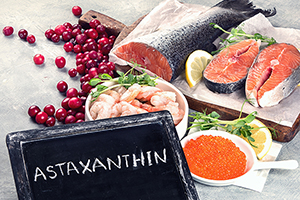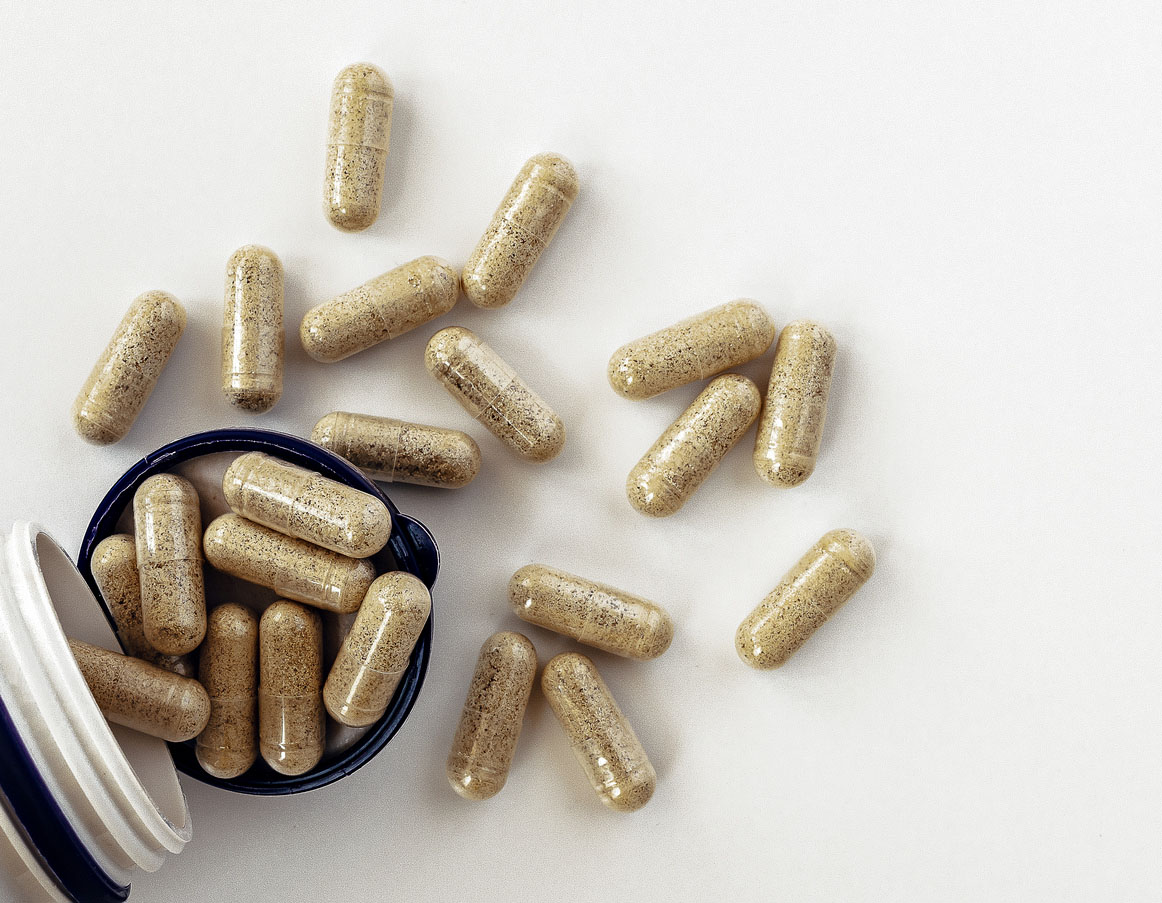—Dr. Ronald Hoffman
This article contains content from one of our trusted sponsors.
Astaxanthin is a red-orange xanthophyll closely related to other carotenoids, such as beta-carotene, zeaxanthin and lutein, as they share many of the same metabolic and physiological functions in the body. In nature, astaxanthin is the main carotenoid pigment found in aquatic animals and is present in salmon, trout, red seabream, shrimp, lobster and fish eggs. It is also what gives some birds their characteristic colors; flamingoes obtain large quantities of astaxanthin when eating brine shrimp and algae. The alga Haematococcus pluvialis< is known to accumulate the highest levels of astaxanthin in nature. Commercially grown H. pluvialis can accumulate more than 30 g of astaxanthin per kg of dry biomass. Astaxanthin has several essential biological functions in the aquatic animals in which it is found: protection against oxidation of essential polyunsaturated fatty acids, protection against UV light effects, immune response, pigmentation, and many others.1
Astaxanthin’s main biological function is to remove free radicals responsible for oxidative stress.* Laboratory experiments suggest that astaxanthin has higher free radical quenching potency than other carotenoids. Due to its interesting pre-clinical biological properties, astaxanthin has been extensively tested in clinical settings to confirm these experimental results for human health. For example, in young, healthy soccer players supplementing their diet with 4 mg astaxanthin daily for 90 days, the authors observed that the astaxanthin-supplemented group had a better response to exercise-generated immune dysfunction and oxidative stress.* It also attenuated the increase of biological markers of normal transitory exercise-induced muscle damage.*2 Astaxanthin can penetrate blood-brain and blood-retinal barriers, which allows for unique biological properties. Although the biological effects of astaxanthin influence many organs, this article focuses on its clinically-validated effects on the brain, eyes, muscles, and skin.3
When it comes to brain health, clinical evaluations suggest that supplementing the diet with astaxanthin supports healthy cognitive function and promotes a positive mood.* In 44 healthy, Japanese volunteers (aged 40+) with mild forgetfulness, supplementation with 9 mg astaxanthin or placebo per day for 12 weeks resulted in a significant improvement in memory scores on objective cognitive function tests as well as subjective symptoms of linguistic remembrance (p<0.05 for both).*4 In another study evaluating the effect of astaxanthin on mood, 28 healthy, active adults (avg. age of 42) received 12 mg astaxanthin or placebo per day for eight weeks. Mood was evaluated using a validated psychological mood state survey (POMS, Profile of Mood States) to assess global mood state and six subscales: Vigor (V), Tension (T), Depression (D), Anger (A), Fatigue (F), and Confusion (C). At the end of the eight weeks, volunteers in the astaxanthin group had a significantly reduced POMS score when compared to placebo (p<0.05), indicating a more positive psychological mood state.* Depression and Fatigue subscales were also significantly reduced, supporting the hypothesis that astaxanthin has a positive effect on mental wellness.*5
Astaxanthin has long been expected to be beneficial for eye health, and this hypothesis has been validated by recent clinical studies.*3,6 In a 2020 study involving 60 healthy adults administered 9 mg astaxanthin or placebo per day for six weeks, near-vision acuity was tested before and after playing a video game (Tetris). The subgroup of volunteers aged 40+ administered astaxanthin showed a significant difference compared to the placebo group in visual data after video gaming at week 6 (−0.126 ± 0.094 vs. −0.038 ± 0.086, p<0.05).* In the subgroup of volunteers under 40 years of age, a better pupil constriction rate was observed in the group receiving astaxanthin than in the placebo group.* These results as well as the results of other clinical studies highlight how astaxanthin supplementation may help counter eye fatigue related to the widespread use of compact terminals, such as smartphones and tablets.6
The effect of astaxanthin on muscle function has also been extensively studied both in laboratory and in clinical studies. In animal studies, mice receiving astaxanthin derived from H. pluvialis had better endurance than mice taking other forms of astaxanthin.*7 Several human clinical studies have evaluated the effects of astaxanthin on muscle function. These studies have shown that astaxanthin helps with muscle recovery after intense exercise and may help to improve muscle strength.*7 In two clinical studies using 4 mg astaxanthin derived from H. pluvialis per day in healthy young men, a significant improvement of strength endurance (increased number of knee squats) and an increase in performance and power output (improvement in 20 km cycling time trial) were observed.*8,9 Furthermore, the effect of 12 mg per day of the same form of astaxanthin resulted in a 7% decrease in heart rate in overweight individuals subjected to a cycling ergometer for 4 weeks.* These findings suggest that astaxanthin supplementation may offer some cardiometabolic benefits to overweight individuals, and may be a favorable supplement for overweight individuals beginning an exercise program.*10
Finally, astaxanthin has also been studied for its benefits on skin health.* During these investigations, astaxanthin, when taken orally and/or topically, has demonstrated its ability to support skin hydration, promote smooth skin, enhance skin elasticity and to help mitigate other visible signs of skin aging.*11 One clinical study conducted in Japan with 65 healthy women receiving either 6 or 12 mg of astaxanthin orally per day for 16 weeks showed no change in wrinkle depth or moisture vs. baseline in the astaxanthin group; however, both wrinkle depth and moisture significantly increased in the placebo group over the same period of time.* In the same study, skin elasticity improved in the astaxanthin group but not placebo group.*12
The health benefits of astaxanthin are well established, but is supplementation necessary and safe? And are all astaxanthin products the same? Although astaxanthin is naturally present in the diet in small quantities, it is difficult to obtain several milligrams per day when following a typical American diet, so supplementing with astaxanthin as a dietary supplement is often helpful. The safety of astaxanthin supplementation is well established. No significant toxicity has been reported in at least 87 clinical trials involving 2,000+ participants using short-term daily doses (up to 100 mg) and long-term daily doses (between 8 and 12 mg) of non-synthetic astaxanthin. No indicators of liver toxicity have been reported in any clinical studies. No severe adverse events have been recorded; reddening of stool is the only minor adverse event occurring at high daily doses.13 Finally, not all forms of astaxanthin are the same. For example, synthetic astaxanthin may have a different safety profile than astaxanthin derived from H. pluvialis, as well as a different free radical quenching potency.13 When choosing an astaxanthin dietary supplement, make sure the ingredient is extracted from H. pluvialis and offers at least 4 mg astaxanthin per serving to reap all the benefits from this extraordinary carotenoid.
References:
- Guerin M, Huntley ME, Olaizola M. TRENDS in Biotechnology. 2003;21(5):210-216.
- Baralic I, Andjelkovic M, Djordjevic B, et al. Evid Based Complement Alternat Med. 2015;2015:783761.
- Donoso A, González-Durán J, Muñoz AA, González PA, Agurto-Muñoz C. Pharmacological Research. 2021;166:105479.
- Sekikawa T, Kizawa Y, Li Y, Takara T. Pharmacometrics. 2019;97(1/2):1-13.
- Talbott S, Hantla D, Capelli B, Ding L, Li Y, Artaria C. EC Nutrition. 2019;14(3):239-246.
- Giannaccare G, Pellegrini M, Senni C, Bernabei F, Scorcia V, Cicero AFG. Mar Drugs. 2020;18(5).
- Wong SK, Ima‑Nirwana S, Chin KY. Experimental and therapeutic medicine. 2020;20(4):2941-2952.
- Malmsten C, Lignell A. Carotenoid Sci. 2008;13:20-22.
- Earnest CP, Lupo M, White KM, Church TS. Int J Sports Med. 2011;32(11):882-888.
- Wika AA, Reason KW, Green JM, Killen LG, McAllister MJ, Waldman HS. International Journal of Exercise Science. 2023;16(2):252.
- Davinelli S, Nielsen ME, Scapagnini G. Nutrients. 2018;10(4):522.
- Tominaga K, Hongo N, Fujishita M, Takahashi Y, Adachi Y. Journal of clinical biochemistry and nutrition. 2017;61(1):33-39.
- Brendler T, Williamson EM. Phytotherapy research : PTR. 2019;33(12):3090-3111.







